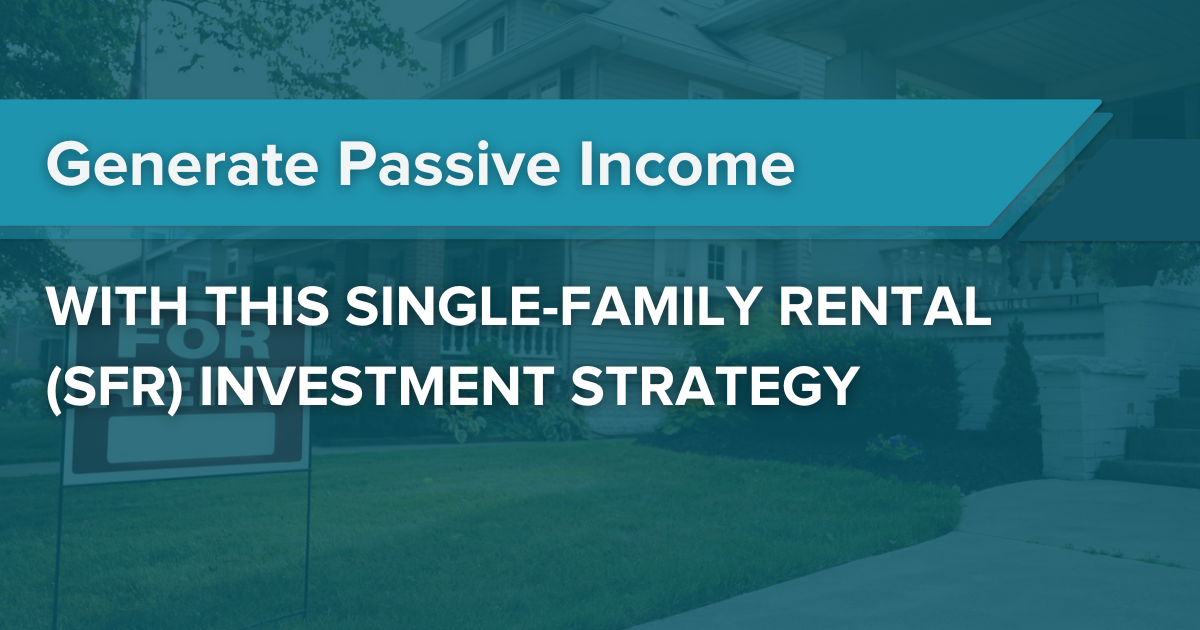A single-family rental investment strategy is an excellent source of passive income. Imagine earning a steady stream of income without the daily grind. With single-family rentals, you can! But it takes the right knowledge, funding, and partners.
Read on to learn more about a single-family rental investment strategy that could help you reach financial freedom to live the life you want.
What Is Single-Family Rental Investing?
Single-family rental (SFR) investing is buying single-unit homes to rent out. Typically, owners earn regular rental income while benefiting from property appreciation.
As a result, SFRs can be a great long-term investment—especially since they are always in high demand. People need a place to live, after all, and single-family houses make up the majority of U.S. homes (82 million of the 129 million occupied units in 2021).
But what sets single-family rentals apart from other property types and assets?
Benefits of Single-Family Rental Investing
Here are the biggest advantages of investing in single-family rentals:
Low Barrier to Entry
Compared to commercial real estate, single-family rentals are much smaller and have a lower barrier to entry. You can even invest as little as a few dollars via a real estate investment trust (REIT) or crowdfunded deal dedicated to SFRs.
Many Financing Options
Single-family homes can be financed in many ways. Instead of getting a traditional mortgage, you can get a DSCR loan from an asset-based lender like ABL.
Regular Cash Flow
Owning rental properties can generate passive income for investors. Meaning, after paying operating costs, whatever money is left over from rent payments is your profit to keep. You can use it to buy additional properties, pay down debt, or even retire.
Potential Appreciation
Typically, single-family homes appreciate over time. In fact, home sales prices rose from $327,900 to $420,400 between Q3 2020 and Q3 2024, a 28% increase. For investors operating under long-term strategies, single-family rentals not only bring in regular cash flow but create sustained value for your portfolio.
Tax Breaks
Operating single-family rentals affords investors the opportunity to write off operating expenses (e.g. maintenance, repairs, utilities, insurance, etc.), property taxes, mortgage interest, and even depreciation from your taxable income. And if you ever sell and reinvest the proceeds into another “like-kind” property, you can defer capital gains taxes via a 1031 exchange.
Potential Risks of Single-Family Rental Investing
Of course, single-family rental investments aren’t without risk. Here are a few to consider:
Market Downturns
While property values tend to go up in the long run, your local market could suffer from an economic downturn, demographic shift, or natural disaster. As a result, your investment may perform worse than expected.
Vacancy Costs
If you lose a tenant, you must still pay the property’s mortgage, taxes, and other expenses. That means until you find a replacement tenant, the property will likely suffer from negative cash flow.
Problem Tenants
While most single-family renters are responsible tenants, some aren’t. Some may pay rent late or not at all, which could lower your returns and require costly legal action such as ordering an eviction. However, you can limit this risk with thorough tenant screening.
10 Steps to Investing in Single-Family Rentals
Now that you know the benefits and risks of single-family rentals, here’s how to invest in them:
- Set investment criteria. This involves determining your budget for a down payment, closing costs, and any cash reserves. From there, you can narrow your investment criteria to single-family homes of a certain size, age, location, etc.
- Research the market. Look for a market with attractive amenities, low crime rates, and a growing population and economy. These are signals that rental demand may be high. Once you’ve chosen a market, examine its current rental rates and property values.
- Find a property. Start shopping for homes for sale in your desired market. Consider hiring a local real estate agent who specializes in single-family rentals. They can alert you to potential deals (on and off the market) that meet your criteria.
- Conduct due diligence. Once you’ve found a property you like, assess its condition and potential ROI. If the property needs work, consider the BRRRR investing strategy, which is all about rehabbing distressed homes and turning them into thriving rentals.
- Secure financing. Unless you can pay all cash (and want to), it’s time to secure a real estate investment loan. These come in many forms, but the fastest and most flexible options are asset-based loans, which weigh the investment’s potential over your personal financial history.
- Make an offer. Based on your market research and due diligence, submit a purchase offer. Don’t forget to include proper contingencies and be prepared to negotiate terms with the seller.
- Close the deal. Pay the closing costs and sign on the dotted line to finalize the deal.
- Prepare the property. Make any necessary repairs and upgrades to prepare the property for renters, and set a competitive rental price based on your market research.
- Find tenants. Advertise your new single-family rental by listing it on online rental marketplaces or posting a “For Rent” sign outside the property. Don’t forget to screen rental applicants by checking their employment, credit, background, and past landlord references.
- Manage and adapt. Keep up with regular property maintenance and tenant relations or outsource to a property manager. Over time, you can adjust your rental rates and overall investment strategy based on market conditions and the property’s performance.
Secure Funding for Your Next Single-Family Rental
As a beginner single-family rental investor, you may find the perfect deal but lack funding. If that’s you, consider partnering with ABL. We offer flexible loan terms and require as few as zero points. Contact us today to prequalify with no obligation!







0 Comments